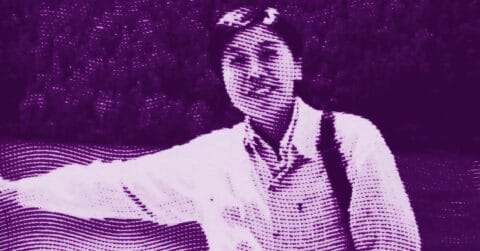Listen to me carefully, you bunch of snobs, there are artists who paint not to decorate your bourgeois living rooms, but to tear apart the veil of our certainties and confront us with the abysses of the contemporary feminine condition. Tania Marmolejo belongs to that rare species of artists who refuse the ease of prettiness to explore the shifting territories of identity and desire. Her work, far from the aesthetic complacencies of our time, imposes itself as a profound meditation on the complexity of the feminine experience in a world in constant mutation.
This Dominican-Swedish artist, born in 1975 in Santo Domingo, embodies in her very path the cultural hybridizations that characterize our globalized era. Trained in Norway, the Dominican Republic, and at the Parsons School of Design in New York, Marmolejo has been able to draw from this geographical and cultural diversity to forge a singular plastic language. Her art does not merely juxtapose influences: it transforms them into an original synthesis that questions notions of belonging and identity.
Marmolejo’s large canvases first strike by their assumed monumentality. These female faces of imposing dimensions look at us with a disturbing intensity; their disproportionately enlarged eyes seem to absorb all the light of the exhibition space. This enlargement strategy is no accident: it proceeds from a gesture of resistance in the face of those who, in the commercial art world, dared to qualify her work as “too feminine.” In response to this sexist criticism, the artist chose to amplify her formats, transforming her portraits into unavoidable presences that physically impose themselves in the spectator’s space.
The archetype of the contemporary feminine
Tania Marmolejo’s work finds a particular resonance when examined through the prism of Jungian psychoanalysis, notably the concept of anima [1]. Carl Gustav Jung defined the anima as the personification of all feminine psychological tendencies present in the male unconscious, but this notion can be extended to understand the archetypes of the feminine that inhabit our collective imagination. Marmolejo’s characters seem to embody these archetypal figures, navigating between innocence and sensuality, vulnerability and power.
The ambiguous expressions of her female figures evoke the different developmental stages of the anima described by Jung: from the primitive maternal figure to the spiritual guide Sophia, including the lover Helen and the Marian figure. These women with enigmatic gazes carry within them the multiplicity of female roles, refusing to be locked into a single category. They embody what Jung called the mediating function of the anima, serving as a bridge between the conscious and the unconscious, between the rational and the intuitive.
The artist herself acknowledges that her characters are not self-portraits in the strict sense, but they carry a part of herself. This approach corresponds to Jung’s conception according to which archetypes manifest through personal experience while transcending the individual to touch the universal. Marmolejo’s women thus become projection surfaces for viewers, each recognizing their own questions about female identity.
The artist’s painting technique, which involves painting directly on the canvas without any preliminary sketch, recalls the process of active imagination dear to Jung. This method allows the unconscious to express itself directly, without the censorship of the rational mind. Marmolejo herself describes this process as expressionist, letting the expressions of the faces evolve autonomously during the creation. This approach reveals an intuitive understanding of the mechanisms of the collective unconscious, allowing archetypes to manifest spontaneously on the canvas.
The turbulent backgrounds surrounding her characters, stormy skies, lush vegetation, moving natural elements, evoke the unconscious forces that stir the psyche. These environments symbolize inner turmoil, repressed passions, and creative energies that characterize the animic dimension of human experience. Unlike her central figures, which remain fixed and contemplative, these backgrounds translate the dynamism of the unconscious, always moving, always transforming.
The influence of her multicultural Scandinavian and Caribbean heritage can also be read as an embodiment of Jung’s theory of psychic compensation. The sometimes dark and melancholic, sometimes vibrant and tropical tones of her works reflect this cultural bipolarity that enriches her emotional palette. This duality is not a conflict but a creative synthesis, enabling the artist to access a broader and more nuanced expressive register.
Magical realism as a visual narrative strategy
Tania Marmolejo’s art is part of an aesthetic lineage with Latin American magical realism [2], a literary movement that profoundly marked the culture of that region in the 20th century. Like writers Gabriel García Márquez or Alejo Carpentier, the artist integrates fantastic elements into a realistic context, creating a poetics of ambiguity that questions the boundaries between the rational and the irrational, the everyday and the extraordinary.
Magical realism, as theorized by Carpentier in his essay “Lo real maravilloso americano” (The marvelous real Latin American), finds its origins in the meeting between indigenous worldviews and European influences, creating a blended reality where the marvelous is an integral part of daily life. This aesthetic of hybridization perfectly corresponds to Marmolejo’s experience, a Caribbean artist trained in Europe and established in the United States, navigating multiple cultural worlds.
Marmolejo’s characters possess the enigmatic quality inherent to figures of magical realism: they seem to evolve in a parallel world where the laws of ordinary psychology no longer entirely apply. Their fixed and penetrating gazes evoke secret knowledge, a connection with invisible forces reminiscent of the mysterious atmosphere of García Márquez’s stories. These women are not merely portraits: they become allegories of the contemporary female condition, bearers of ancient wisdom and troubling modernity.
The artist’s painting technique participates in this aesthetic of magical realism. Her delicate impastos and subtle glazes create material effects that oscillate between hyperrealism and stylization. The pearly flesh of her characters seems animated by an inner life, while their flowing hair sometimes defies gravity. This technical ambiguity strengthens the impression of a world where the natural and the supernatural coexist harmoniously.
The environments surrounding her figures also partake in this poetry of the everyday marvelous. Lush forests, stormy skies, dreamlike architectures mingle in compositions that evoke the mental landscapes dear to writers of magical realism. These settings are not mere backdrops: they constitute psychological spaces where the inner dramas of her characters unfold.
Marmolejo’s art shares with magical realism the ability to transform the ordinary into the extraordinary by the sheer force of the gaze. Like the narrators of García Márquez who describe the most fantastic events with apparent detachment, the artist presents her visions with a disturbing obviousness. This naturalization of the marvelous constitutes one of the most effective strategies of magical realism, allowing the viewer to accept the unacceptable and see the invisible.
The political dimension of magical realism also finds an echo in Marmolejo’s work, notably through her series “Master and Commander” dedicated to Iranian women. By transforming political resistance into visual allegories, the artist aligns herself with the tradition of Latin American writers who used fiction to circumvent censorship and express forbidden truths. Her women with defiant gazes become symbols of resistance, figures of emancipation that carry the hope of a fairer world.
This lineage with magical realism does not stem from imitation but from a contemporary reinvention of the aesthetic codes of this movement. Marmolejo adapts the narrative strategies of magical realism to the specifics of the pictorial medium, creating a visual language that retains the poetic and critical force of its literary models while asserting her artistic singularity.
Contemporary art and its resistances
In the current landscape of contemporary art dominated by spectacular installations and new technologies, Tania Marmolejo’s work asserts the resistance of figurative painting. This position is not nostalgic but strategic: it responds to a need to rehumanize art in the face of the conceptual and commercial excesses that characterize our time. Her large canvases function as islands of contemplation in a world saturated with ephemeral images and visual solicitations.
The artist’s commitment to oil painting, the traditional medium par excellence, reflects a desire to situate herself in the continuity of art history while renewing it. Her assumed references to Renaissance and Baroque masters, notably in her dramatic use of chiaroscuro, testify to a solid artistic culture that nourishes her contemporary language. This scholarly approach contrasts with the historical amnesia that characterizes part of current creation.
The critical reception of her work reveals the tensions that run through the contemporary art market. Long confined to the circuits of commercial illustration and textile design, Marmolejo had to conquer her artistic legitimacy in the face of a milieu often wary of creators from applied arts. Her recent success in the Asian market, where her works reach prices several times above estimates, testifies to a recognition that transcends Western prejudices.
This trajectory sheds light on the mechanisms of artistic validation in a globalized world. As noted by art critic Florence Ho of Sotheby’s Hong Kong, Asian collectors seem less sensitive to the traditional hierarchies between “fine art” and decorative arts. They perceive in Marmolejo’s work a successful synthesis of technical excellence and contemporary relevance, qualities that align with their aesthetic criteria.
The evolution of the artist’s status also reveals the transformations of the contemporary art system. Her shift from commercial illustrator to recognized artist illustrates the increasing permeability of boundaries between different fields of visual creation. This transition testifies to her adaptability and strategic intelligence, essential qualities in an increasingly competitive artistic environment.
Towards an aesthetics of emancipation
Tania Marmolejo’s art is part of a broader movement of women’s reappropriation of female representation by women artists. Her characters escape the stereotypes of the femme-object that have long dominated Western art to propose complex and contradictory figures bearing autonomous subjectivity. This approach aligns with contemporary feminist struggles while avoiding the pitfalls of explicit activism.
The strength of her approach lies in her ability to universalize the female experience without disembodying it. Her women remain deeply human, traversed by recognizable emotions, while accessing a symbolic dimension that goes beyond the anecdotal. This tension between the particular and the universal constitutes one of the major challenges of contemporary art, often torn between political engagement and aesthetic autonomy.
The recent evolution of her practice towards even more monumental formats reflects growing ambition. These imposing works transform the exhibition space into a theater of contemplation, forcing the viewer to establish a physical and emotional relationship with the depicted characters. This immersion strategy contrasts with the ironic distance that characterizes much of contemporary art.
Her growing success on the international art scene should not overshadow the challenges that lie ahead for her. The transition from emerging artist to established market value is often accompanied by commercial pressure that can affect creative freedom. Her ability to preserve her artistic integrity in the face of market demands will be a major test for the rest of her career.
The recognition Tania Marmolejo enjoys today reflects an evolution in contemporary artistic sensibilities. Her art, which reconciles tradition and modernity, technique and emotion, resonates with an audience seeking meaning and beauty. This positive reception suggests that the future of art does not necessarily lie in systematic rupture with the past but can follow paths of creative synthesis respectful of cultural heritage.
While our artistic world is often dominated by trends and financial speculation, Marmolejo’s work reminds us that authentic art is born from inner necessity and technical mastery. Her canvases, far from conceptual ease, require the viewer to make an effort of contemplation and understanding that reconnects with the traditional functions of art: to move, to question, to elevate. This aesthetic demand, far from elitist, opens spaces for dialogue and sharing between the artist and her audience.
The art of Tania Marmolejo ultimately invites us to reconsider our relationships with image and representation in an age saturated with visual stimuli. Her silent and meditative figures serve as contemplative refuges amidst contemporary turmoil. They remind us that behind every gaze lies a universe of complexity and mystery, which art has the mission to reveal and celebrate. In this, her work transcends the simple aesthetic framework to touch upon fundamental questions of human existence and our relationship to the world. It teaches us that true artistic revolution does not lie in a clean break with the past, but in the ability to reinvent inherited forms to express the urgencies of the present.
This artist of the cultural diaspora, navigating between Nordic and tropical influences, embodies the creative possibilities of our blended era. Her art proves that it is possible to build a unique oeuvre by fully embracing multiple heritages, without nostalgia or rejection, but in a dynamic synthesis that enriches contemporary artistic heritage. In this sense, Tania Marmolejo does not merely add her voice to the artistic concert of our time: she helps to renew its score, opening unprecedented paths for future generations of artists seeking authenticity and relevance.
- Jung, Carl Gustav. The Archetypes of the Collective Unconscious, Gallimard, 1977.
- Carpentier, Alejo. “The Marvelous Real American”, 1949.
















